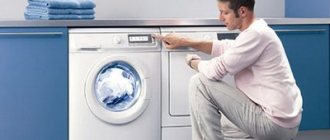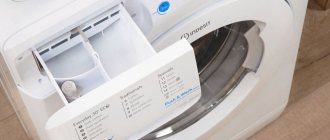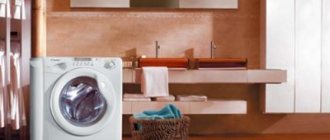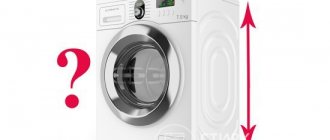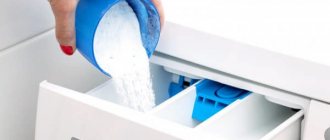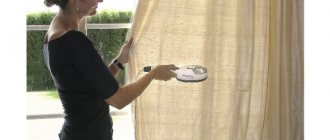When buying a washing machine, you should focus on several basic parameters that determine its class: size and type of load, washing efficiency, spin type and energy efficiency. Knowledge about each of these criteria will ultimately help you choose the optimal model that will serve its owner for many years and will suit him not only visually, but also technically.
- Generally accepted classification
- Why do they give an "A" grade?
- Washing class
- Spin class
- Energy class
- Types by size and loading
- Is drying necessary?
- Additional functions
- What to look for when purchasing
- Catalog of washing machines with reviews
Generally accepted classification
Are you using citric acid?
Oh yes! No
You can understand the quality of the washing machine in front of you by focusing on a special classification developed by European countries. Models of this type of household appliances are evaluated according to three main indicators: energy consumption, washing quality and spin performance.
In all of these parameters there is a gradation by class, where “A” is the highest grade and “G” is the lowest. Each vehicle parameter is assigned 7 ratings:
- “A” and “B” are excellent and good grades, respectively;
- “B” and “C” – very good and not bad;
- “D” and “E” – normal and satisfactory;
- "F" and "G" are bad and very bad.
General classification
It turns out that any machine will receive at least three ratings. The latest options are practically not produced, and it is also unlikely that anyone would want to purchase equipment that is already known to be ineffective. But if, nevertheless, such a model is found on the consumer market, then there is no need to buy it.
It is worth paying attention to the fact that the classification system is only a basis that changes and is modernized over time. Thus, depending on the parameter of energy efficiency and washing, new classes have appeared: “A+”, “A++” and also “A+++”.
Help: determining the class of the selected model is not difficult even for a beginner - this data is located on a special sticker on the body of the machine. Usually the manufacturer does not hide them, but on the contrary, makes them most noticeable.
Cotton wash quality
This indicator is denoted by six letters of the English alphabet - from A to G. It is determined as a result of various tests and trials. They consist of washing fabric of a certain size with stains applied.
After adding the powder, which must be from the same manufacturer for all tests, the standard washing mode is started with a set temperature of 60 degrees. In case of dirt residues, the item is compared with the washing results of a reference machine.
If the test machine completed the wash with the best performance, it will be given the highest class - "A". If the results are the same, the unit receives the letter “B”. In all other cases, the class depends on the number and size of remaining stains and dirt.
The last time the standard was set was 23 years ago. During this time, washing quality standards have increased significantly. Car manufacturers are also trying to keep up with progress. Therefore, since 2000, it has been almost impossible to find cars of the latest classes.
Almost all units offered on the market correspond to the highest indicator - “A”. Despite this, sometimes you can find devices of groups “C” and “D”. The unique owner of the “D” class is the Candy CR 81 model. A number of TM DEU cars belong to the “C” group. Therefore, when buying a new device, you should make sure that it belongs to category A.
Sukhanov Ilya Arkadyevich, head of the testing laboratory of household appliances and electronics, NP Roskontrol: “If earlier we assessed the quality of washing using the so-called mud target with 6 contaminants, using a cotton washing program at 60 degrees Celsius, now there are 11 types of contaminants (fruit and vegetables, sauces, drinks, cosmetics, shoe polish, gouache paint and ink), and two washing programs are used: at 60 and 40 degrees Celsius. To eliminate accidents, each wash is repeated at least three times. If the variation from time to time is greater than acceptable, additional test washes are carried out. As a result, a cumulative assessment of the quality of washing for each washing machine is formed based on more than fifty results.”
The washing quality of the “narrow” model WF1802XEY, produced in China, turned out to be slightly lower (up to 8 kg load and up to 1200 rpm spin; pictured), although the lag behind the leaders was only 2 points. A little less time, electricity and water were spent on washing with this machine. But let’s not forget that it also fits less laundry. In terms of per kilogram of loading, the result is parity.
Read more: Do-it-yourself water supply in a private country house, installation and installation
Why do they give an "A" grade?
For any of the parameters (washing efficiency, spinning and energy consumption), a rating of “A” or “very good” is top notch. It is placed if the SMA performs the specified function at a high level:
- Washing class “A” is assigned if the machine removes all stains and is as efficient as possible.
- Spin class “A” is assigned depending on the residual moisture content of the laundry (in this case it should not exceed 45%).
- In terms of energy efficiency, the most economical washing machine in terms of energy consumption receives an “A” rating.
Class A+++
Which washing and spinning class is better?
The required washing class in a washing machine is determined based on your needs. Often families have small children, which contributes to the appearance of difficult-to-remove stains. Playing sports or physical work, such as repairing a garage, also leads to soiled clothing. What is the best class of washing in washing machines to take - the highest possible A or at least B. If the activity is not associated with the risk of stains, you can consider C. It is not recommended to take a lower one, since such models are outdated.
Washing class
One of the main functions of a washing machine is to combat stains on fabric. The efficiency indicator for this parameter just demonstrates the washing class. There is also a generally accepted gradation from “A” (washing is very good) to level “G” (very weak).
A completely logical question arises: why is this or that technique awarded a certain class? Naturally, it is possible to determine how well SMA erases only under experimental conditions. IN
As a starting point, a standard machine is taken, which copes with this no better or worse than others, but always shows a constant result. Under the same conditions, on the same piece of fabric, a test is carried out, based on the results of which a verdict is made:
- The highest score, or “A” rating, is given to a machine whose washing class is defined as excellent (its efficiency index is 1.3).
- Very good wash o (index – from 1 to 1.3).
- A good wash is assigned class “C” (index – from 0.97 to 1).
- Normal is designated by the letter “D” (index – from 0.94 to 0.97).
- Satisfactory is “E” (index – 0.91 to 0.94).
- The bad one gets o (index – from 0.88 to 0.91).
- Very poor washing o (index – 0.88-0).
Expert opinion
I work in the household appliance repair industry. Extensive experience in restoring washing machines and dishwashers.
Ask a Question
Important! Today, manufacturers have begun to produce a new generation of washing equipment with a washing class of “A+” and higher, however, their price can be much more expensive. But is such a machine worth the money? Practice shows that in the issue of washing efficiency, not only the machine itself plays an important role, but also the cleaning agent and the nature of the contamination. That is, you can simply use a good powder - and equipment with class “C” will cope with stains on clothes no worse than machines marked with the signs “A” and “B”. That is, this factor matters, but there is no need to chase the highest rating and overpay.
What criteria are used to assign a washing class?
No matter how trivial it may sound, the washing class is assigned to the machine according to the quality of the wash. In this case, a special test is carried out in which the tested “washer” is compared with the reference one. During the test, the same amount of powder is poured into both devices, a piece of fabric with artificially applied identical stains is placed in the washing drum, after which an hour-long wash is started at 60 degrees Celsius. The results of the latter’s effectiveness are determined by automatic technology, after which experts carry out the necessary calculations, and the SMA finally receives its “letter”.
Let's dwell a little on class A. According to international standards, this class is given to a “washing machine” that can cope with any dirt on any fabric with the correct selection of the washing mode. Fabrics should not be damaged in any way during such washing. It is worth noting that if we are talking about washing everyday items of any color other than white, then washing class A will be impossible to distinguish from washing class B, no matter what the “professionals” say.
Interesting! The production standards of the “reference” machines with which modern ones are compared have become a little outdated over time. An ordinary class A model today washes on average 1.03 times better than the “standard”.
When talking about the most important parameters for any washing machine, we cannot fail to mention the energy consumption and spin classes. The first determines how much energy is needed for a high-quality wash, and is indicated by the same letters of the Latin alphabet, but with slight differences.
New technologies allow manufacturers to achieve lower and lower energy consumption rates, and today on the markets you can find equipment with energy consumption levels designated as A+, A++ and even A+++. The more “pluses”, the less electricity is required for operation and the less the owner will ultimately spend.
As for the spin level, it’s even easier. This indicator determines the amount of moisture remaining in the washed laundry that is given to the user. This amount depends not only on the maximum rotation speed of the drum, but also on its diameter. The most powerful machines today have a maximum drum rotation speed of 1400–1500 rpm.
Reference. You should not assume that the more intense the spin, the better the quality of the wash: small differences in the speed of rotation of the drum become clearly noticeable only if we are talking about low speeds. In practice, it is quite difficult to distinguish two things pressed, for example, at 1200 and 1400 rpm. This difference becomes noticeable only on dense fabrics.
Since high-quality spin affects the final weight of items after washing, machines with a high spin class will be useful for fragile housewives, as well as people who do not like to spend a lot of time drying or those with small everyday wardrobes. There is an opinion that top-loading machines wring out clothes much better, but this is not always the case, and their operating vibration is usually stronger.
Spin class
An important parameter for washing equipment is the spin class. It shows as a percentage how wet your items will be after washing. This indicator directly depends on the number of revolutions of the machine per minute. That is, the more often the drum rotates, the drier things will be.
The percentage of humidity can be easily calculated - it is the ratio of the weight of the laundry before and after the washing process. Depending on the spin class, washing machines are assigned ratings from “A” to “G”, each of them corresponds to a certain humidity and speed:
- The best spin quality is marked with the letter “A”, with which the residual moisture content of the laundry will be less than 45%.
- The “B” value indicates that after spinning the fabric will remain 45-54% damp.
Do you wash by hand?Oh yes! No
- “C” means that the technique will spin the laundry, leaving it at 54-63%.
- A value of 63-72% guarantees class “D”.
- “E” means that after washing the items will be 72-81% damp.
- “F” corresponds to a result of 81-90%.
- A machine with class “G” after washing will show the laundry humidity to be more than 90%.
In addition, the spin efficiency depends on the diameter of the drum and the time it takes to complete the full spin cycle. The longer the time and the larger the drum, the drier the laundry will be.
The dryness of the fabric is also affected by the permeability of the material. So, a chiffon blouse and jeans after washing together will have a different percentage of moisture.
Important! A higher spin class is not always good. Strong - will deform the fabric. Obviously, for regular washing of ordinary and delicate materials, class “D” is quite suitable. It is believed that machines with 1000 - 1200 drum revolutions per minute are suitable for any laundry.
Most modern washing machines have several spin modes programmed into them; this is also worth paying attention to when purchasing.
Proportion of dry fabric depending on class
How to assign a class to a washing machine
Washing machine wash grades are established by comparing a newly created model with a benchmark invented in the mid-1990s. The model spends a minimum amount of energy with high operating efficiency.
To assign a class to a washing machine, it is tested. The experiment simultaneously involves devices from several companies. The washing process uses the same detergents, the same modes and items. Then the laundry is assessed by a special device. At the next stage, the quality of the wash is compared with the electrical energy spent to establish the overall level of efficiency of the device. The quality of the spin is also assessed.
Power consumption level
The level of electrical energy consumption does not affect the safe operation of the equipment. The machine is turned on simultaneously with the TV and other household appliances not only in new buildings, but also in buildings of the Soviet period. Wiring problems are not an obstacle to using the machine. But if the wiring is thoroughly damaged, the use of any device operating from the network is unacceptable.
Until the beginning of the 2000s. There were 7 categories of energy consumption (from A to G). Models consuming 0.19 kWh/kg or less were considered economical. Modern manufacturers offer even more economical equipment.
Spin categories
The category depends on the number of revolutions per minute, which can vary from 600 to 1600.
For effective spinning, a machine with a rpm speed of 1000 to 1200 is sufficient.
However, it is not always worth choosing a model with a rapidly rotating drum. Reasons why consumers refuse it:
- High speed leads to premature wear of equipment.
- Rapid rotation is not acceptable when spinning some items, such as silk underwear. Delicate clothes are spun at 400 rpm or manually.
- With the accelerated rotation of the drum, things are pressed tightly against each other and wrinkled. Such clothes are difficult to iron.
Accelerated spin rotation is not required when washing less than 7 kg of dirty laundry. No more than 1000 rpm is enough. For small apartments, category C equipment is recommended, which has a small washing tank. The quality of the spin cycle is determined by the amount of moisture remaining in the laundry:
- Marking A means that the items are 55% dry or more.
- B - 46-55%.
- C - 37-46%.
- D - 28-37%.
- E - 19-28%.
- F - no more than 10-19% liquid.
- When spinning in a category G appliance, the laundry will be less than 10% dry.
Energy class
A good washing machine should be economical in energy consumption. The corresponding marking will show how energy-saving it will be:
- “A+” (newest generation) – electricity consumption – 0.17 kW/h.
- Class “A” shows that the machine will consume from 0.17 to 0.19 kW/h.
- In the case of “B”, electricity consumption will range from 0.19 to 0.23 kW/h.
- Class “C” consumption will be from 0.23 to 0.27 kW/h.
- A machine marked “D” will consume between 0.27 and 0.31 kWh.
- Equipment marked “E” will consume from 0.31 to 0.35 kW/h.
- Class “F” washing machine – from 0.35 to 0.39 kW/h.
- The most expensive will be “G” - from 0.39 kW/h.
Expert opinion
I work in the household appliance repair industry. Extensive experience in restoring washing machines and dishwashers.
Ask a Question
Important! The energy consumption class is indicated per kilogram of items. Therefore, in order to calculate the exact value of electricity consumed per wash, you need to multiply the indicated number by the weight of the laundry.
Competition in the car market today is great and manufacturers fight for buyers by constantly modernizing them. The usual classification of cars from seven ratings (“A” – “G”) has long included equipment with the “A+” sign. But the leaders in the production of washing machines do not stop there - in retail chains you can increasingly find models of a higher class.
Example of a tag on a car
Types of classes in the machine
7 main groups have been developed that determine the efficiency of the device, the quality of washing and spinning, as well as its energy consumption. The better the washing results, the higher the class of equipment. Let's take a closer look at the existing classes and analyze their characteristic features and parameters.
Washing classes
A
Such washing machines provide effective removal of all types of stains. This is an ideal solution as it ensures clean and fresh laundry. The quality factor is at least 1.03. This means that the machine copes with dirt slightly better than the reference model (1.03 times).
IN
They also have fairly good quality indicators; the coefficient of such specimens is in the range of 1-1.03. Washing quality is comparable to reference models.
WITH
The parameters of such models are lower. In particular, the quality factor is in the range of 0.97-1. However, this is also very good.
D
The washing quality of such washing machines is normal, the coefficient is 0.87-0.94.
E
The models are characterized by satisfactory performance, the quality index is in the range of 0.91-0.94.
F
The washing quality of these machines is poor, the coefficient is 0.88-0.91. That is, the machine practically does not wash off dirt.
G
Both models of this type and the previous one are practically never found, because any conscientious manufacturer will not allow the production of such copies. The performance of products of this class is characterized as very poor, the quality factor is unacceptable and amounts to 0.75-0.88. However, if you encounter a product of this type, you should not purchase it.
Spin classes
The spinning process is based on the action of centrifugal forces that “push” water out of the fabric. This process is characterized by a criterion called residual moisture. This is the amount of moisture remaining in the material at the end of the spin cycle. The dryness of the laundry depends on the rotation speed and volume of the drum, the throughput of the material and the duration of the process. The following classes are distinguished.
A
These models have the highest drum rotation ratio (more than 1500 rpm) and a spin ratio of less than 45%. Suitable for removing moisture from rough, dense materials. It should be noted that delicate tissues may not withstand such intensity of rotation. Therefore, if you wash mainly light fabrics, for example, underwear, lace, fine wool, it is better to choose a lower class option.
IN
The spin coefficient is 45-54%, the drum rotation speed is 1200-1500. Also a very strong level, suitable for terry fabrics. It should be noted that the first two classes of machines vibrate excessively during spinning, which is not always practical or convenient.
WITH
The amount of residual moisture in washed laundry is about 54-63%, speeds of about 1000-1200 are considered optimal for all types of fabrics, including coarse fabrics. Slightly damp laundry can be easily dried on a line. The main thing is that it will not tear as a result of spinning.
D
The spin ratio is 63-72%. The devices ensure drum rotation at a speed of 800-1000 rpm. This is the best option for most cotton and synthetic fabrics.
E
The parameter characterizing the quality of spin is in the range of 72-81%. Quite an intense effect on the fabric. The number of revolutions in the range from 600 to 800 is ideal for delicate fabrics.
F
Spin – 81-90% and number of revolutions – 400-600. This means that things remain wet after washing. Suitable for thin fabrics only.
G
The spin ratio is more than 90%, the rpm is less than 400. This is a very poor quality of the process; the machine will only spin very thin fabrics. In terms of the degree of spin, this type is comparable to manual.
Energy classes
It is quite easy to check the amount of energy consumed. To do this, you just need to run the standard washing cycle at 60 degrees for one hour. After the end of the cycle, the result is revealed. The machines are classified as follows.
A
Electricity consumption is about 0.17-0.19 kW per hour for every kilogram of laundry.
IN
Electricity consumption of models of this class is from 0.19 to 0.23 kWh/kg.
WITH
Products of this class consume about 0.23-0.27 kWh/kg.
D
Energy consumption – 0.27-0.31 kWh/kg.
E
The devices consume 0.31-0.35 kWh/kg.
F
Electricity consumption - 0.35-0.39 kWh/kg.
G
Electricity consumption – more than 0.39 kWh/kg.
The latter classes belong to the category of devices that consume a significant amount of electricity, while the quality of washing leaves much to be desired. The units practically do not remove stains, and the laundry remains wet after being removed from the drum.
Today, the energy consumption class designated A+ is considered the best option. These are very economical models, consuming less than 0.17 kWh/kg. Also, thanks to the developments of engineers, class A++ and A+++ models are produced. They allow you to save up to 30% of energy resources, resulting in significantly reduced costs. It is quite rare to find class B or C products on store shelves. Even the cheapest models are usually marked with the letter A.
Types by size and loading
Based on the type of loading, machines are divided into frontal and vertical. Frontal ones can most often be found in retail chains - this is a familiar technique with a transparent round-shaped door, reminiscent of a porthole. In a top-loading machine, laundry is placed through a special opening at the top.
There is no significant difference in these two models, except for the location of bearings and dimensions. Here everyone finds what is closest to them.
The size is chosen, usually based on the size of the bathroom and washing needs:
- A machine with a width of 32-35 cm and a load of 3 to 4 kg will fit perfectly even in a small room and is suitable for a family of two. Unfortunately, you cannot wash a down jacket or blanket in it.
- Larger equipment with a capacity of 5 to 6 kg and a width of 40-45 cm can easily cope with washing a large item. Accordingly, it is suitable for serving a family of 3-4 people.
Do you wash your shoes in the machine?
Oh yes! No
Is drying necessary?
There are times when there is no time or opportunity to dry laundry. And here a machine with a drying function comes to the rescue: after such washing, the items are removed completely dry, without requiring hanging.
But this function also has a number of disadvantages:
- rarely found in washing machines;
- significantly increases the cost (from 20%);
- often dries out laundry.
Efficiency classes
Additional functions
Often, equipment sellers try to attract the buyer by listing additional functions of the machine. But what are they and what are they for?
“Quick wash” is the best solution for those who urgently need clean laundry. The cycle in this case lasts from 15 to 30 minutes.
“Delayed start” - a function that helps the car owner save energy. For example, washing starts at night and consumes energy at reduced rates. Or the owner of the equipment simply needs dry laundry at a certain point. You can delay washing from 1 to 24 hours.
“Pre-wash” allows you to remove even stubborn stains. With this function, the laundry is soaked, and then the main cycle is turned on.
“Bio-washing” is a kind of stain removal stage. Before washing, the machine keeps the temperature around 30-40 degrees Celsius so that special granules - enzymes contained in the powder - corrode the dirt.
“Protection against leaks” or “AquaStop” function protects the machine from water leakage after washing. Can be used using: thickened inlet hose, solenoid valve, drip tray. It can be complete or partial.
Are you unplugging your washing machine?
Oh yes! No
Energy efficiency of appliances
Consumers pay much more attention to this parameter than to others. The higher the energy efficiency, the less electricity the machine spends on washing each kilogram of laundry.
Table 3. Energy efficiency of washing machines
| Energy efficiency | Energy consumption, kWh/kg |
| A | {amp}lt;0.17 |
| A | 0,17–0,19 |
| B | 0,19–0,23 |
| C | 0,23–0,27 |
| D | 0,27–0,31 |
| E | 0,31–0,35 |
| F | 0,35–0,39 |
| G | {amp}gt;0.39 |
Until 2002, there were 7 standard energy efficiency classes, the highest being A. In recent years, modern manufacturers have been supplying the market with models with classes A, A and A, which are more than 10% more efficient than A.
Quality checking
It is assigned very simply - the energy costs for washing the same amount of laundry on the test and reference machines are compared. Washing class or quality A means that the model being tested is significantly superior to the reference model.
This indicator is certainly important in washing machines, especially during a constant increase in tariffs. The first tests of energy saving efficiency were calculations of the energy consumed to wash 1 kg of clothes at a temperature of 60 degrees. Over time, the most expensive models were identified from a number of categories (from A to G). They were products of categories “F” and “G”. Instead, new energy efficiency classes appeared - A (, ,).
When choosing these categories, keep in mind the slight difference in savings between the three-plus and two-plus models. Moreover, the cost of the machines themselves can differ by several thousand. Based on this, we can say that savings on washing do not always pay for the money spent on purchasing a more economical model.
Ilya Arkadyevich Sukhanov, head of the testing laboratory for household appliances and electronics, NP Roskontrol: “Evaluating the spin efficiency is quite simple: we weigh and load dry towels into the machine (weighing 50% of the permissible cotton load), run a rinse program with a spin and then weigh the towels again. Weight gain is the moisture remaining in the fabric. The less it is, the better. We consider weight gain to be no more than 35% as a reference result.”
The level of washing depends on the ability of the washing machine to remove dirt and stains from clothing. In other words, this is the efficiency class. There is a method by which classes are determined for each model. The objects being checked are compared with the standard. The standard is a washing machine that fully complies with all quality characteristics.
The tested washers are launched simultaneously with the standard. Identical items with equal degrees of contamination are loaded into the drum. The amount of powder for all machines is also equal. Washing time takes 1 hour at a temperature of 60 degrees Celsius. The whole procedure is reminiscent of an advertisement for washing powder.
Class A is assigned if the wash is of better quality than the standard. Class B and the reference machine wash in the same way, with no difference. It is almost impossible to distinguish the first two classes. This can only be done on white bed linen. When washing clothes multiple times, it will become noticeable which machine is of a higher level.
- Class A washes better than the standard, washing is of the highest quality.
- B - washes clothes at the standard level, very good quality of the process.
- Worse than the standard, but still provides a good wash. It is also recommended to purchase machines with this class; they are budget-friendly and do a good job of washing dirty clothes.
- Class D washing machines wash things neither well nor badly.
- With an E rank, you will receive a satisfactory result after completing the process.
- The remaining 2 classes are highly not recommended to buy. Classes F and G are poor and very poor poor quality washing. As mentioned above, now they are practically not produced.
Read more: How to integrate a dishwasher into a finished kitchen
Note to potential buyer. You should only buy cars of class A or B, in extreme cases C. It is highly not recommended to buy classes that go lower.
What to look for when purchasing
In such a serious matter as choosing a washing machine, you simply need to pay attention to its washing class. But it is not necessary to look for equipment with an “AAA” rating.
For example, in terms of wash quality, you may not even feel any difference between the “A” and “B” ratings. Spin level “C” is quite suitable for weekly laundry care.
The most important parameter, perhaps, remains the energy consumption class. But even in this case, even an indicator at level “A” or “B” will indicate the efficiency of the equipment.
Video
All other factors are selected individually and calculated based on the budget.
Purchasing: what should you pay attention to?
As you might have guessed, when purchasing, the first thing you should pay attention to is the washing class. The price between class “A” and “B” is decent, but you will hardly notice the difference in the result. Therefore, if you want to save your family budget, then cast your vote in favor of the second option. But you shouldn’t pay attention to “C” class washing machines. The difference in price is minimal, and the quality of washing is significantly worse.
As for the quality of the spin cycle, there is no need to strive for perfection. For an ideal wash, an ordinary person will only need class “C”. These are machines with a speed of less than 1200. The laundry will dry much faster after washing. And such a machine will not create unnecessary noise, vibration, and will not “jump” throughout the bathroom.
All necessary parameters are indicated on the washing machine body itself. As a rule, these are bright stickers on which all the information the buyer needs is indicated in large print. Therefore, having previously studied the material, you will not need to contact a sales consultant, because you will be able to make the right choice for yourself.
